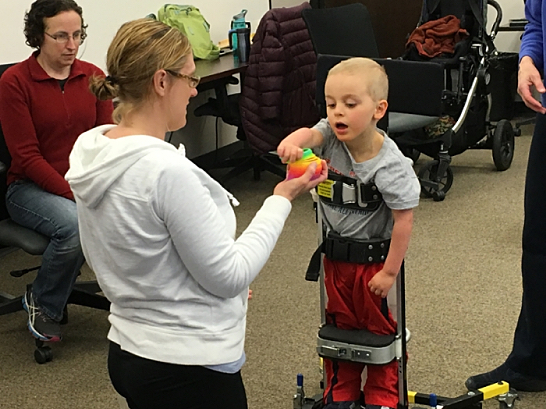Cerebral Palsy: Innovative Physical Therapy Research Improves Kids’ Lives

![]() Few treatment options are available for children with moderate-to-severe cerebral palsy (CP), so when Brayden Starr, 5, was diagnosed as an infant with the brain injury that impairs body movement and muscle coordination, his parents resolved to find ways to provide their son with the best possible quality of life. In their quest, they found Sandra Saavedra, an assistant professor from the University of Hartford’s College of Education, Nursing and Health Professions, and a unique treatment that is dramatically improving Brayden’s abilities.
Few treatment options are available for children with moderate-to-severe cerebral palsy (CP), so when Brayden Starr, 5, was diagnosed as an infant with the brain injury that impairs body movement and muscle coordination, his parents resolved to find ways to provide their son with the best possible quality of life. In their quest, they found Sandra Saavedra, an assistant professor from the University of Hartford’s College of Education, Nursing and Health Professions, and a unique treatment that is dramatically improving Brayden’s abilities.
Brayden, who is unable to walk or talk, was among the first children enrolled in Saavedra’s open study for the treatment called Targeted Training which attempts to teach children with CP how to control spine segments and trunk muscles. Normally, people use the spine as though it is one segment, but it is actually composed of several connected regions. Saavedra works with children with CP and their families to teach them techniques for controlling all of the separate parts.
 Five-year-old Brayden Starr learns to control his spine with Targeted Training. Photo credit: University of Hartford.
Five-year-old Brayden Starr learns to control his spine with Targeted Training. Photo credit: University of Hartford.
 In her research, Saavedra, who directs the Pediatric Balance Laboratory in the university’s Department of Rehabilitation Sciences, found that while postural control of the trunk is essential for independent sitting and creates the basis for most functional movement, little was known about how trunk control normally develops or how it is constrained in children with motor impairment.
In her research, Saavedra, who directs the Pediatric Balance Laboratory in the university’s Department of Rehabilitation Sciences, found that while postural control of the trunk is essential for independent sitting and creates the basis for most functional movement, little was known about how trunk control normally develops or how it is constrained in children with motor impairment.
Her researched aims primarily to understand how segmental levels of trunk control influence and interact with sensorimotor function such as eye-head-hand coordination, reaching, sitting, standing, and walking during typical and atypical development. Saavedra has designed longitudinal studies involving young infants with typical development, and she uses the knowledge gained to design comparable studies involving children with CP or other neurologic dysfunctions. She hopes to develop empirically proven treatments that will improve mobility and health in children with moderate-to-severe motor impairment.
“We assess the children’s control by holding them at their shoulders and determining if they can hold their heads,” Saavedra said in a press release. “If they can, we move down under their arms to see if they have control of their upper spines and heads. We progress our hands down the body one region at a time to see if exactly where they have trunk control.”
After initial assessment of a child with CP, Saavedra and her team (a doctor of physical therapy and students), send the child home with a custom fitted device that helps them stand. Using the device as therapy, the child practices (with parental guidance) controlling his or her spine while the device supports them where needed. The therapy is reassessed at two month intervals.
Brayden, who was in the program for 18 months, can now sit up on his own, said his father Chris Starr.
“Before, he would just fall over after a few seconds,” Starr said. Chris and wife Christina are grateful that Brayden can now play with toys and better interact with his friends and family, having gained more control of his upper body
Saavedra’s ultimately plans to refine Targeted Treatment techniques and the assistive device, which is currently available in the United Kingdom. When the technique is approved in the United States, she will teach other health clinicians how to use the segmental approach so they can provide help to more children nationwide.
The technique is potentially applicable for conditions beyond cerebral palsy, such as treating stroke patients or injured athletes.
During the development of the Targeted Training exercises, Saavedra and her students worked closely with experts in England who created the technique. They also discussed their ideas and findings with a team of international researchers from Denmark, Hong Kong, and England. Saavedra, a researcher with more than 20 years of clinical experience in pediatric physical therapy along with a strong doctoral and postdoctoral research background, is focused on translating clinical needs into research projects that can enhance the evidence base behind pediatric physical therapy.
Saavedra’s study is currently still open to participants. For more information, contact Saavedra at [email protected].
You can watch a video of Brayden’s story here: https://youtu.be/YOK7cnYcldk


